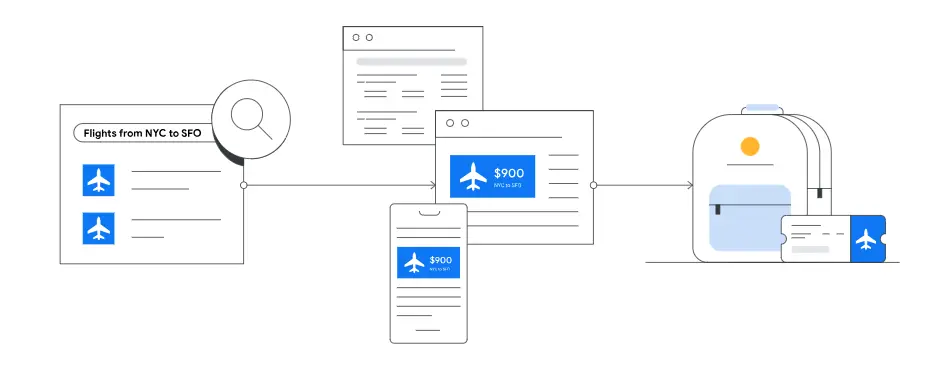When someone visits your website but doesn’t take action—like making a purchase or filling out a form—it can feel like a missed opportunity.
But what if you could give them a gentle reminder, wherever they go online? That’s where retargeting (or remarketing) comes in.
In this article, we’ll break down what remarketing is, how it works in Google Ads, and why it’s such a powerful tool to reconnect with your audience and drive conversions.
Let’s dive in.
What is Remarketing?

Remarketing (sometimes called retargeting) is a way to show ads specifically to people who have already interacted with your website, app, or content in some way.
Imagine someone who browses your online store but doesn’t buy anything. Instead of letting them disappear into the vast world of the internet, you can serve them ads later—maybe while they’re reading the news or watching videos online.
In simple terms, remarketing helps you “stay top of mind” with people who’ve already shown interest in what you offer. And because they already know your brand, they’re more likely to come back and convert.
Google Ads makes this super easy and effective by letting you target these past visitors across millions of websites and apps on the Google Display Network, as well as on YouTube and even in search results when they look for related terms again.
How Does Remarketing Work?

Here’s the basic idea: when someone visits your site, a small piece of code called a remarketing tag (or pixel) is triggered and adds that visitor to a special list—a remarketing list. This list is then used to target ads to those people as they continue browsing the web.
For example, let’s say a visitor looked at your product page but didn’t complete a purchase. With Google Ads remarketing, you can create a specific campaign to show ads promoting that very product (or a special offer) just for that audience.
Google Ads gives you a lot of flexibility—you can create different remarketing lists based on the exact behavior of your visitors. You might want to retarget:
- People who visited your homepage but didn’t go further
- Visitors who abandoned a shopping cart
- Users who completed a form but didn’t follow up
- People who spent a certain amount of time on your site
The magic here is that remarketing ensures your ads are being seen by people who’ve already demonstrated interest, giving you a much better shot at turning them into customers.
Benefits of Remarketing Through Google Ads
Remarketing isn’t just about showing ads to people who’ve already visited your website—it’s about making your advertising more effective. Here are some key benefits of using remarketing through Google Ads:
1. Higher Conversion Rates
Because you’re targeting people who’ve already interacted with your brand, they’re more likely to convert.
Whether it’s completing a purchase or signing up for your newsletter, remarketing brings back those potential customers who were once interested but didn’t follow through.
It’s like giving them a second chance to take action, but this time with an extra nudge.
2. Better ROI (Return on Investment)
With remarketing, you’re focusing your ad spend on people who’ve already shown interest in your business.
This means you’re more likely to see a higher return on investment compared to broad targeting. You’re spending money on ads that are tailored to specific individuals, which leads to better results.
3. Brand Recall and Visibility
Even if someone doesn’t convert right away, seeing your brand’s ads multiple times helps reinforce your message.
Over time, the repeated exposure increases brand recall and recognition. This is a huge advantage for businesses looking to stay top-of-mind with their audience.
4. Customizable and Flexible Campaigns
With remarketing, you can fine-tune your ads to target specific actions. You can create different ad sets for different user behaviors—such as showing discounts to people who abandoned their shopping cart or offering special deals to those who viewed your services page.
It’s a more personalized approach, and personalization typically leads to better outcomes.
5. Cross-Platform Reach
Google Ads allows you to show your remarketing ads not just on websites but across various platforms, including YouTube, Gmail, and Google Search.
This broadens your reach and ensures your audience sees your brand everywhere they go, increasing the likelihood of them engaging with your ads.
Remarketing Options in Google Ads
Google Ads offers a range of remarketing options to suit different business needs and objectives.
These options give you the flexibility to create highly targeted campaigns that speak directly to your audience. Here are some of the most popular types of remarketing you can run:
1. Standard Remarketing
This is the most basic form of remarketing. With standard remarketing, you show your ads to people who’ve already visited your website as they browse other sites in the Google Display Network.
It’s a simple but effective way to remind visitors of your brand and encourage them to return.
2. Remarketing Lists for Search Ads (RLSA)
RLSA allows you to target users who have already visited your website and are now performing searches on Google.
You can customize your bids and ads for this group, which can help you capture high-intent visitors.
For instance, you could bid higher for someone who abandoned their cart but is now searching for similar products—giving you a better chance to win that click.
3. Dynamic Remarketing
Dynamic remarketing takes things up a notch by showing personalized ads featuring the exact products or services that users viewed on your website.
It’s like an automatic product catalog tailored to each user’s interests, which increases the likelihood of them returning to make a purchase. For e-commerce businesses, this is a game-changer!
4. Remarketing for Mobile Apps
If you have a mobile app, you can use remarketing to bring back users who have installed your app but haven’t used it in a while.
You can target them with specific offers or reminders to re-engage them with your app. This is a great way to keep your app users active and boost your app’s retention rate.
5. Video Remarketing
You can also target users who have engaged with your YouTube videos or channel.
This gives you the chance to promote your services to people who have already shown an interest in your content, helping you build stronger relationships and encourage more interactions.
How to Start a Remarketing Campaign in Google Ads?
Starting a remarketing campaign in Google Ads is easier than you might think. Here’s a simple step-by-step guide to help you set up your own remarketing campaign and get started on the right foot:
1. Set Up Google Ads and Google Analytics
Before anything, make sure you have both Google Ads and Google Analytics set up for your website. These tools will work together to track visitor activity and create your remarketing lists.
- Link your Google Analytics account with Google Ads to allow for seamless tracking.
- Make sure your remarketing tags are installed correctly on your website to track visitors. This involves adding a small piece of code to your website—don’t worry, Google provides a step-by-step guide for this.
2. Create Your Remarketing List
Once the tag is in place, go to your Google Ads account and start creating your remarketing list.
You can segment this list based on different actions your visitors took, such as visiting a product page, adding an item to the cart, or completing a purchase. The more specific the list, the better your campaign will perform.
3. Design Your Remarketing Ads
Now that your lists are ready, you’ll need to create remarketing ads. These ads should be eye-catching and relevant to the behavior of your target audience.
If someone abandoned their cart, show them ads for the products they left behind, possibly with a discount or offer to entice them to return.
You can create both image ads for the Display Network and text ads for search campaigns, or even try video ads for platforms like YouTube.
4. Set Your Bid and Budget
Determine your campaign’s budget and set your bidding strategy. You can choose from various bidding options like Cost Per Click (CPC) or Cost Per Thousand Impressions (CPM), depending on whether you want to focus on clicks or impressions.
5. Choose Your Targeting and Launch the Campaign
Now, decide where you want your ads to appear. Google Ads gives you the flexibility to target based on location, device, and time of day. Once everything looks good, launch your campaign and start monitoring its performance.
6. Monitor and Optimize
After your campaign is live, keep an eye on your Google Ads performance metrics like CTR, impressions, and conversion rate.
Based on how your remarketing ads are performing, you can adjust your bids, budget, and even try A/B testing to see which ads resonate the most with your audience.
Conclusion
To sum it all up, remarketing in Google Ads is a powerful tool that allows you to re-engage people who’ve shown interest in your brand but haven’t taken the final step to convert.
By serving targeted ads across multiple platforms, remarketing helps boost conversions, increase brand recall, and maximize your ad spend efficiency.
If you’re looking to implement a remarketing campaign for your business but don’t know where to start, Ostenpowers is here to help!
Our expert Google Ads consultants in Sydney specialize in setting up and optimizing remarketing campaigns tailored to your business needs.
So, why not let Ostenpowers take your Google Ads to the next level? Reach out today and see how we can help you achieve your marketing goals with expert targeting, optimized ads, and a smart remarketing strategy that works for you.









